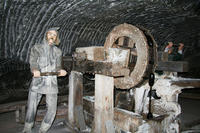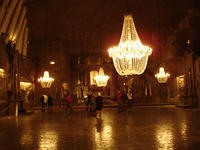You are in: Europe -> Poland -> Wieliczka Salt Mine, and traditional search or Image Gallery will yield results of this site only
Wieliczka Salt Mine
| Site number: | 32 |
|
| Type of site: | Cultural | |
| Date: | 13th century | |
| Date of Inscription: | 1978 | |
| Location: | Europe, Poland, Lesser Poland (Malopolska) Voivodship, City and County of Wieliczka | |
Up to 75 images are shown here. Click on each for more details or on Image Gallery for more images.
| Description: | Since the 13th century people have mined this rock salt deposit in Wieliczka-Bochnia. The 300 km of galleries holding works of art, altars, and salt sculpted statues are Spread over nine levels, creating an enthralling pilgrimage into the past of a chief industrial activity. --WHMNet paraphrase from the description at WHC Site, where additional information is available. | |
| The Wieliczka Salt Mine, in the town of Wieliczka, in Poland's Kraków metropolitan area, had until 2007 been in continuous operation, producing table salt, since the 13th century. It was one of the world's oldest operating salt mines (the oldest being at Bochnia, Poland, 20 kilometers from Wieliczka). Active mining stopped in 1996 due to low salt prices and mine flooding, most likely caused by mining operations. The mine now remains open only for touring. The mine reaches down to a depth of 327 meters, and is over 300 km. long. The Wieliczka salt mine features a 3.5-km. tourist route (less than 1% of the length of the mine's passages) that includes statues of historic and mythic figures, all sculpted by miners out of the rock salt. Even the crystals in the chandeliers are fashioned of salt. Also featured are beautifully carved chambers, chapels, an underground lake, and exhibits on the history of salt mining. The mine is justly referred to as "the underground salt cathedral of Poland." About 1.2 million people visit the mine each year. Over the centuries, visitors to this site have included Nicolaus Copernicus, Johann Wolfgang von Goethe, Alexander von Humboldt, Dmitri Mendeleyev, Bolesław Prus, Ignacy Paderewski, Robert Baden-Powell, Jacob Bronowski (who filmed segments of The Ascent of Man in the mine), Karol Wojtyła (the later Pope John Paul II), former U.S. President Bill Clinton, and crowned heads. During World War II, the salt mine was used by the occupying Germans as housing for war-related production plants. The awe-inspiring, ancient labyrinthine salt mine helped inspire the Labyrinth scenes in Bolesław Prus' 1895 historical novel, Pharaoh. In 1978 the Wieliczka salt mine was placed on the original UNESCO roster of World Heritage Sites. --Wikipedia. Text is available under the Creative Commons Attribution-ShareAlike License. | ||
| Source: | http://whc.unesco.org/en/list/32 | |
| Source2: | http://whc.unesco.org/en/list/32/video | |
| Reference: | 1. UNESCO World Heritage Center, Site Page. | |

























